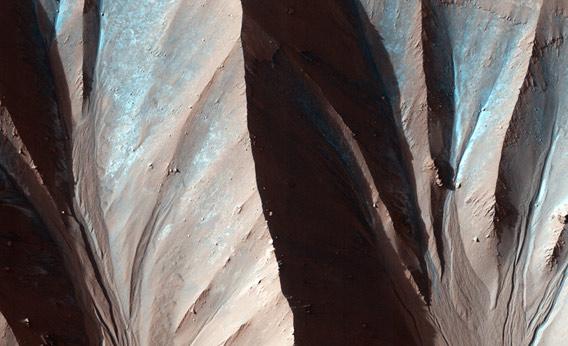Create a free profile to get unlimited access to exclusive videos, sweepstakes, and more!
New Gullies Found in a Young(ish) Crater on Mars

My first two science loves are, in order, astronomy and geology. If you combine the two your options are limited. You can observe the Earth from space, you can collect meteorites, or you can soak in the beauty of landscapes on other worlds provided by spacecraft.
I have a deep affection for all three, and which one I like best depends on when you catch me. For example, today, Iâm fond of that last one, due to this gorgeous picture taken of ridges and gullies on Mars:
This shot shows some of the terrain (or aresain or whatever term you use for Mars) inside Gasa crater, a 7 kilometer (4 mile) wide crater in the southern mid-latitude of the red planet. Weirdly, Gasa sits inside a larger 20-km-wide crater; whatever impact formed it happened in the same place as a larger impact a long time before. Gasa is young, probably less than two million years old.
The edge of Gasa is heavily scalloped, clearly caused by the rim eroding away. Thereâs a lot of carbon dioxide ice in this location, much of it beneath the surface. Every summer the ground warms up, the ice sublimates (turns directly into a gas) and some of the crater rim collapses inward.
Over time this forms gullies, erosional channels. Theyâre not terribly hard to find in some craters, since they look like, well, gullies: nearly straight channels in the crater wall dug out by material flowing downhill. There are fan-shaped regions surrounding them, and in the top image, which has been color enhanced, the fans are bluish, showing fresh deposits of carbon dioxide.
How fresh? This picture was taken in the austral spring of Mars, and those deposits werenât there the year before! So the CO2 ice was laid down last winter in the Martian southern hemisphere, just months ago.
Mars is not a dead planet, at least not geologically. It changes year by year, even month by month.
Hereâs a close-up, taken from the full-res image:
You can see how sharp the ridges are. The Sun is shining down from the upper left, and the tops of the ridges look like a knifeâs edge. You can also see boulders dotting the landscape as well, casting long shadows. Thatâs convenient, since the size of the boulders can be directly measured, and the angle of sunlight is known. That means the slope of the ridges can be determined, too. Itâs amazing what you can squeeze out of an image like this.
It gets better, too. Here is a wider shot, showing more of the crater rim:
See how the scalloped region with gullies is on the right? Thatâs the northern rim of the crater. Now think this through: In the southern hemisphere summer, when itâs warmer, the Sun will be shining more directly into the northern rim of the crater (just like having southern exposure in a house in the northern hemisphere on Earth gets you more sunlight). Thatâs why thereâs more erosion there on the northern rim; the ground gets warmer and frees more carbon dioxide. As you look around the crater rim in both directions (east and west, heading south) the scalloping gets weaker, because the ground doesnât get as much direct sunlight, and so is somewhat cooler.
Thatâs evidence of seasonal variation in the erosion, just like youâd see on Earth!
Mars is such an odd place. Thick gray basaltic sand is everywhere, covered itself by fine dust (tinged red due to iron oxide: rust). Cratered, battered, barely holding an atmosphere, yet it still has ways of reminding us of home. Comparative planetology is a fascinating field.
Huh. I may have to make that Number 3 on my list.


























